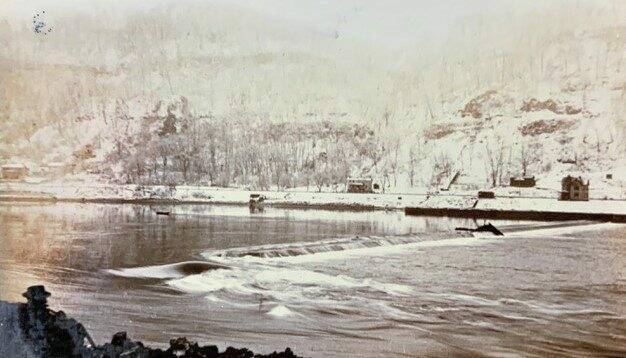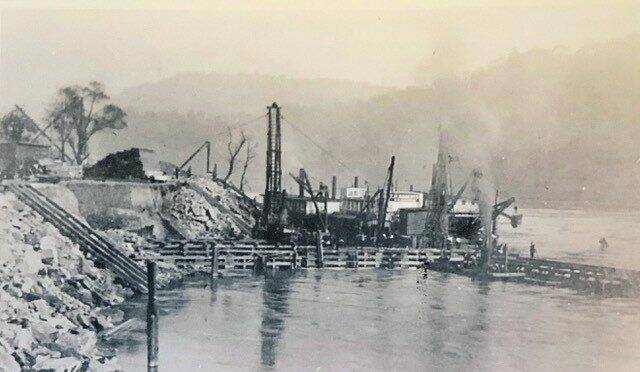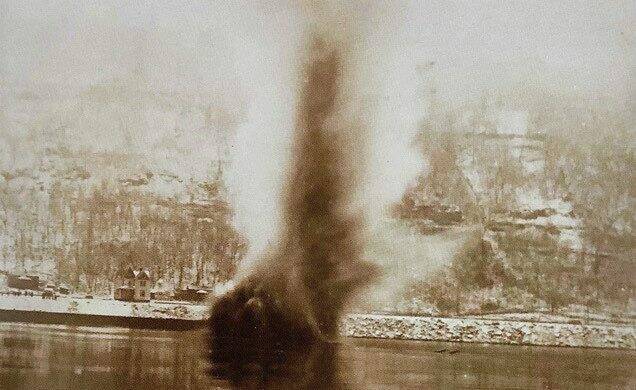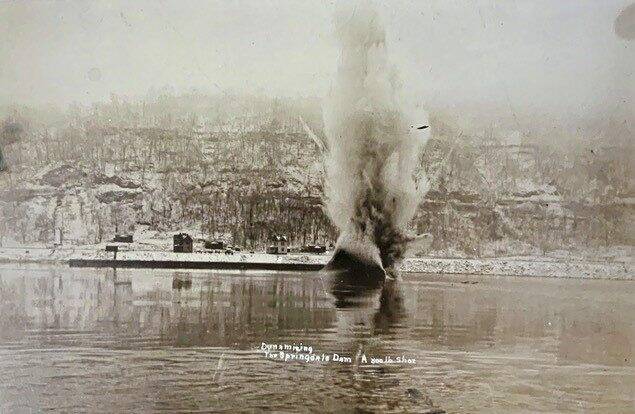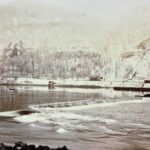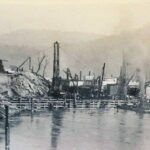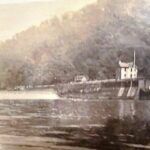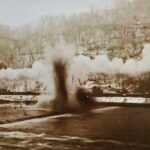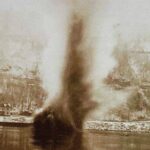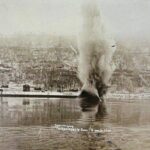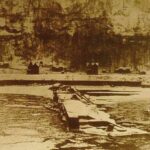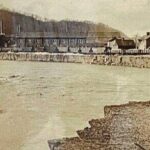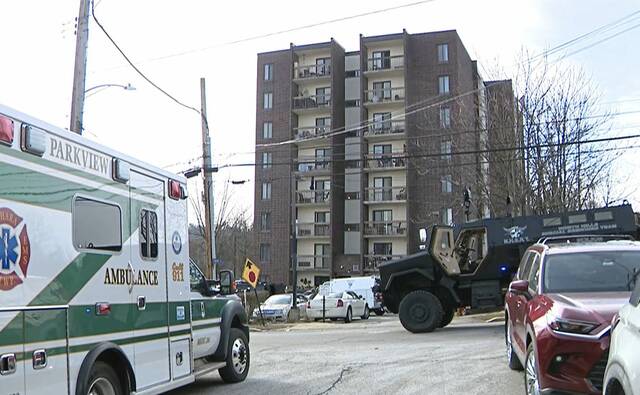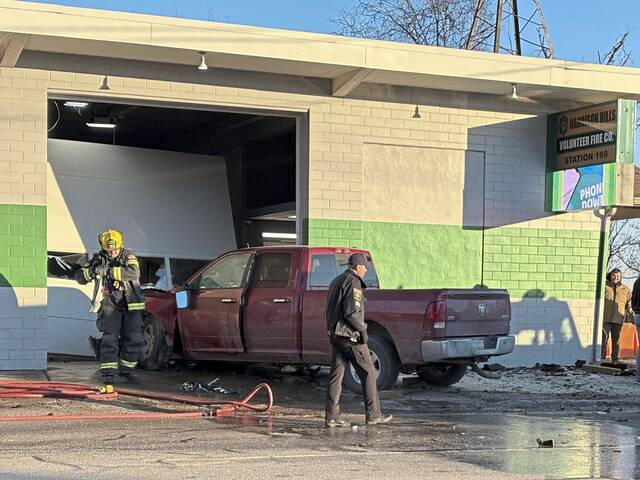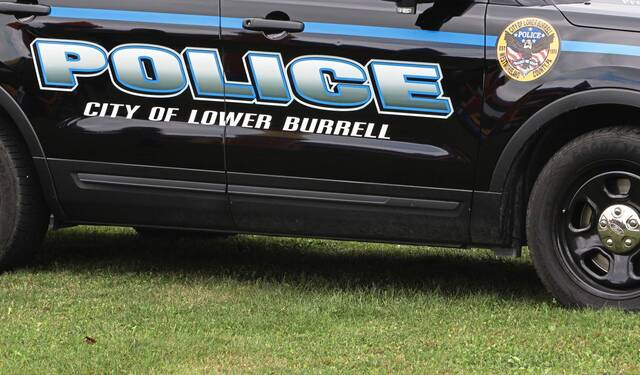The concrete locks and dams along the Allegheny River were built in the 1920s and 1930s, but three dams built around 1900 preceded them.
Lock and dam No. 1 was located at Herrs Island near the present 31st Street Bridge. Lock and dam No. 2 was built slightly upstream from the present Highland Park Bridge. Lock and dam No. 3 was near the bottom of Center Street in Springdale, where R.I. Lampus Co. currently is located. It crossed the river to the Logans Ferry side near the Barking section of Plum.
In addition to improved navigation, these early dams were built for other reasons.
There was concern that railroads were becoming too powerful. Utilization of the rivers would provide competition and prevent the railroads from developing a monopoly.
The construction of the dams caused an industrial boom from Pittsburgh to Oil City. They opened the immense coal fields of more than 20,000 acres which ran from Verona to Braeburn.
Prior to the dams, travel on the river was dependent on seasonal rains. At times, there was not sufficient water in the river channels for boat traffic. During these dry periods, ponding would occur.
As communities developed in the Alle-Kiski Valley, the river was used as a dumping ground for industrial waste and sewage from people’s homes.
The stagnant water in the ponds along the riverbed during dry spells became a tremendous problem. They were breeding grounds for mosquitoes, typhoid and other diseases.
Newspapers reported 30 cases of typhoid in one day in Pittsburgh’s East End attributed to contaminated water being drawn from the river into the reservoir at Highland Park.
The system of dams later provided a constant flow of water which flushed the river channel and alleviated these problems.
Cause for celebration
At noon on July 28, 1903, when lock and dam No. 1 was formally opened on the Allegheny River, every steam whistle from Pittsburgh to Bradys Bend blew for five minutes in celebration.
In February 1898, Judge Joseph Buffington appointed a group of seven men, who were known as viewers, to acquire land for the construction of a dam on the Allegheny River at Springdale. The dam would be the farthest upriver on the Allegheny.
Work on the dam began later that year with the construction of lock No. 3 on the Logans Ferry side of the river. The lock was completed by fall 1900, and dredging began for the foundation of the dam. A deep 60-foot-wide trench was dug and wooden piles were driven. The dam was built of wooden pile walls with rock fill and concrete.
In April 1901, at Ross Station near Fox Chapel, an explosive charge was set off using 2,400 pounds of gunpowder and 700 pounds of dynamite to obtain the rock fill for Springdale dam.
The explosion was one of the largest blasts ever set off in this part of the country. The blast could be heard for miles, and many local residents were frightened. The explosion and its shock waves were likened in newspapers to an earthquake.
This work on the dams was done in concert with the clearing of boulders, sand bars and snags along the Allegheny River to improve navigation.
The Springdale dam was completed in 1903 and resulted in higher water levels, called slackwater, extending back as far as Tarentum.
One of the casualties of the higher water level above the Springdale Dam was the loss of a free public beach between Ninth and 10th streets in New Kensington, known as Pebble River Beach. It had been a popular swimming spot during the 1890s.
Rampant flooding issues
In the first decade of the 1900s, there still were large timber rafts traveling the Allegheny River. Many of these were too large to use the locks on the river.
Rather than disassemble the rafts, many of the rivermen decided to jump the dams. This is similar to white-water rafting that is done today, but the dangerous practice often damaged the dam, leading to constant repairs.
The Springdale Dam also experienced a number of floods. The greatest and most devastating occurred in January 1907.
The floodwaters undercut the concrete and stone retaining walls on the Springdale side, causing them to fall into the river. Once this occurred, the fast-moving water began to wash away the land behind them.
Ten houses were washed away and numerous others were threatened. Also at risk was the Heidenkamp Mirror Works near the dam.
The West Penn Railroad installed three spurs so stone and slag could be brought close to the site to arrest the erosion of the riverbanks and protect the railroad’s main line.
Three trains filled with immense blocks of limestone from Hollidaysburg and 200 hopper cars loaded with slag from the Carnegie mills were hurried to the disaster site.
Large trees were felled and bound together with cables to form mats that were placed along the banks to prevent scour. Hundreds of laborers toiled day and night in efforts to stem the damage caused by the floodwaters.
Springdale at risk
It soon became apparent that the efforts were insufficient, and there was concern that the lower part of Springdale would be washed away unless more drastic measures were taken.
The decision was made to dynamite the dam to open the river channel and relieve pressure on the riverbanks.
On Jan. 18, 1907, two boats were used to dynamite the dam. They were taken a considerable distance upriver. The first boat was anchored. It contained a battery and a long rope bound to an electrical wire. The second boat contained the explosives and was attached to the anchored boat by means of the rope.
The rope was played out slowly, allowing the current to carry the boat with the explosives downriver. When it reached the dam, the dynamite was set off. Ten shots of dynamite were used. The first seven were 200 pounds each, and the last three were between 450 and 500 pounds each.
The last shots were spectacular, throwing 20-foot timbers as high as 250 feet in the air and a plume of water and gravel even higher.
The series of explosions made a breach of 75 feet in the dam. The explosions broke windows and dropped plaster from ceilings in homes as far away as Tarentum.
The next day, 12,000 pounds of dynamite was used to remove an additional 200 feet of the dam. Three hundred rail cars filled with heavy stone were brought to Springdale to secure the banks of the railroad’s main line.
On Jan. 20, 1907, the Secretary of War ordered the United States engineer in charge of other improvements on the Allegheny River to take possession of all property along the river between the riverbank and the West Penn Railroad from 500 feet above the Springdale Dam to 1000 feet below it.
The property would be appraised, and purchases would be made at a later date.
With the flood over, on Jan. 24, 1907, the federal government passed an appropriation of $200,000 for repairs to the Springdale Dam.
The design called for lowering the dam 1 foot and extending the abutments 125 feet into the Allegheny River. Part of the dam and the abutments were to be faced with steel sheeting to prevent future washouts.
Fill was proposed for the end of the dam, and it was to be overlayed with riprap. The design was adopted, and the work was completed in 1908.
In 1910, the federal government decided not to purchase the land it had seized in 1907 but elected to restore it to its preflood condition and return it to its former owners.
The Springdale Dam remained in service until 1934, when it was removed and replaced by the new dam at Acmetonia.


